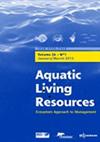直接多重PCR-NALFIA为海洋保护提供信息:使用一种创新的诊断工具来检测毛竹Ostrea edulis幼虫
IF 1.9
4区 农林科学
Q3 FISHERIES
引用次数: 0
摘要
欧洲牡蛎(Ostrea edulis)通过提供多种生态系统功能和服务,在北海发挥了关键作用。今天,在欧洲,毛竹被归类为严重退化或功能性灭绝。海洋保育的重点是生物礁的恢复,即在北海的Natura 2000地点恢复O. edulis。与恢复珊瑚礁自然落落有关的牡蛎幼体鉴定和幼体漂移监测是海洋保护区管理的一个重要方面。形态学鉴定和从其他丰富的双壳类幼虫用显微镜区分是困难的。现有的分子生物学方法是昂贵的,并且受限于固定的实验室设备,或者在可视化方面是不够的。在这项研究中,我们确定了核酸侧流免疫分析法(NALFIA),一种完善的人类病原体诊断工具,作为海洋监测中即时检测(POC)的有效方法。根据毛竹线粒体细胞色素b的基因序列,开发了正、反向引物。反向引物用荧光染料FITC标记,正向引物用生物素标记。在便携式PCR仪上,用多引物直接PCR,可以实现单株毛豆幼虫在横向流动条带上的反应。所建立的NALFIA系统可以分别将O. edulis幼虫与长牡蛎(creasstrea gigas)和Mytilus edulis幼虫区分开来。该方法为海洋研究和监测中的POC测试提供了新的途径。它给出快速和清晰的结果,价格低廉,并且可以很容易地适应其他感兴趣的物种。本文章由计算机程序翻译,如有差异,请以英文原文为准。
Direct multiplex PCR-NALFIA to inform marine conservation: Use of an innovative diagnostic tool for the detection of Ostrea edulis larvae
The European oyster Ostrea edulis played a key role in the North Sea by providing several ecosystem functions and services. Today, O. edulis is classified as severely degraded or functionally extinct in Europe. Marine conservation is focusing on biogenic reef restoration, namely the restoration of O. edulis in Natura 2000 sites of the North Sea. The identification of oyster larvae related to natural spatfalls of restored reefs and monitoring of larval drift is a key aspect of marine protected area management. Morphological identification and distinction from other abundant bivalve larvae using microscopy is difficult. Existing molecular biological methods are expensive and bound to stationary laboratory equipment, or are inadequate in the visualization. In this study, we identified nucleic acid lateral flow immunoassay (NALFIA), a well-established tool in human pathogen diagnostics, as an efficient approach for point-of-care (POC) testing in marine monitoring. Based on the genetic sequence of the mitochondrial cytochrome b of O. edulis, forward and reverse primers were developed. The reverse primer was labelled with fluorescent dye FITC, forward primer with biotin. Reaction on the lateral flow stripe could be realized with a single O. edulis larva in direct PCR with multiplex primers in a portable PCR-cycler. The established NALFIA system can distinguish O. edulis larvae from Crassostrea gigas and Mytilus edulis larvae, respectively. This method offers new approaches in POC testing in marine research and monitoring. It gives quick and clear results, is inexpensive, and could be easily adapted to other species of interest.
求助全文
通过发布文献求助,成功后即可免费获取论文全文。
去求助
来源期刊

Aquatic Living Resources
农林科学-海洋与淡水生物学
CiteScore
2.30
自引率
0.00%
发文量
10
审稿时长
>24 weeks
期刊介绍:
Aquatic Living Resources publishes original research papers, review articles and propective notes dealing with all exploited (i.e. fished or farmed) living resources in marine, brackish and freshwater environments.
Priority is given to ecosystem-based approaches to the study of fishery and aquaculture social-ecological systems, including biological, ecological, economic and social dimensions.
Research on the development of interdisciplinary methods and tools which can usefully support the design, implementation and evaluation of alternative management strategies for fisheries and/or aquaculture systems at different scales is particularly welcome by the journal. This includes the exploration of scenarios and strategies for the conservation of aquatic biodiversity and research relating to the development of integrated assessment approaches aimed at ensuring sustainable and high quality uses of aquatic living resources.
 求助内容:
求助内容: 应助结果提醒方式:
应助结果提醒方式:


